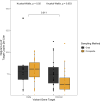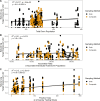The influence of environmental factors on the detection and quantification of SARS-CoV-2 variants in dormitory wastewater at a primarily undergraduate institution
- PMID: 39792012
- PMCID: PMC11792549
- DOI: 10.1128/spectrum.02003-24
The influence of environmental factors on the detection and quantification of SARS-CoV-2 variants in dormitory wastewater at a primarily undergraduate institution
Abstract
Testing for the causative agent of coronavirus disease 2019 (COVID-19), severe acute respiratory syndrome coronavirus 2 (SARS-CoV-2), has been crucial in tracking disease spread and informing public health decisions. Wastewater-based epidemiology has helped to alleviate some of the strain of testing through broader, population-level surveillance, and has been applied widely on college campuses. However, questions remain about the impact of various sampling methods, target types, environmental factors, and infrastructure variables on SARS-CoV-2 detection. Here, we present a data set of over 800 wastewater samples that sheds light on the influence of a variety of these factors on SARS-CoV-2 quantification using droplet digital PCR (ddPCR) from building-specific sewage infrastructure. We consistently quantified a significantly higher number of copies of virus per liter for the target nucleocapsid 2 (N2) compared to nucleocapsid 1 (N1), regardless of the sampling method (grab vs composite). We further show some dormitory-specific differences in SARS-CoV-2 abundance, including correlations to dormitory population size. Environmental variables like precipitation and temperature show little to no impact on virus load, with the exception of higher temperatures for grab sample data. We observed significantly higher gene copy numbers of the Omicron variant than the Delta variant within ductile iron pipes but no difference in nucleocapsid abundance (N1 or N2) across the three different sewage pipe types in our data set. Our results indicate that contextual variables should be considered when interpreting wastewater-based epidemiological data.
Importance: Testing for severe acute respiratory syndrome coronavirus 2 (SARS-CoV-2), the causative agent of coronavirus disease 2019 (COVID-19), has been crucial in tracking the spread of the virus and informing public health decisions. SARS-CoV-2 viral RNA is shed by symptomatic and asymptomatic infected individuals, allowing its genetic material to be detected and quantified in wastewater. Here, we used wastewater-based epidemiology to measure SARS-CoV-2 viral RNA from several dormitories on the Appalachian State University campus and examined the impact of sampling methods, target types, environmental factors, and infrastructure variables on quantification. Changes in the quantification of SARS-CoV-2 were observed based on target type, as well as trends for the quantification of the Delta and Omicron variants by sampling method. These results highlight the value of applying the data-inquiry practices used in this study to better contextualize wastewater sampling results.
Keywords: SARS-CoV-2; droplet digital PCR; wastewater-based epidemiology.
Conflict of interest statement
The authors declare no conflict of interest.
Figures





References
-
- Lorenzo M, Picó Y. 2019. Wastewater-based epidemiology: current status and future prospects. Curr Opin Environ Sci Health 9:77–84. doi:10.1016/j.coesh.2019.05.007 - DOI
-
- Jiménez-Rodríguez MG, Silva-Lance F, Parra-Arroyo L, Medina-Salazar DA, Martínez-Ruiz M, Melchor-Martínez EM, Martínez-Prado MA, Iqbal HMN, Parra-Saldívar R, Barceló D, Sosa-Hernández JE. 2022. Biosensors for the detection of disease outbreaks through wastewater-based epidemiology. Trends Anal Chem 155:116585. doi:10.1016/j.trac.2022.116585 - DOI - PMC - PubMed
-
- Betancourt WQ, Schmitz BW, Innes GK, Prasek SM, Pogreba Brown KM, Stark ER, Foster AR, Sprissler RS, Harris DT, Sherchan SP, Gerba CP, Pepper IL. 2021. COVID-19 containment on a college campus via wastewater-based epidemiology, targeted clinical testing and an intervention. Sci Total Environ 779:146408. doi:10.1016/j.scitotenv.2021.146408 - DOI - PMC - PubMed
MeSH terms
Substances
Supplementary concepts
Grants and funding
LinkOut - more resources
Full Text Sources
Medical
Miscellaneous

